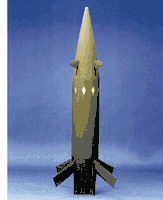Extended Range Guided Munition

The Extended Range Guided Munition was a precision guided rocket-assisted 5-inch (127 mm) Shell (projectile) development by Raytheon for the U.S. Navy. The program was cancelled in March 2008 after twelve years of development and over 600 million dollars in funding.[1] The developmental round was designated EX 171.[2] ERGM consisted of three major subsections; propulsion (rocket motor), warhead, and Guidance, Navigation and Control section. ERGM is fired from the 5 inch 62 Caliber Mark 45 gun Mod 4 at which point the fins deploy, rocket motor would ignite and lift the munition to at least 80,000 feet (24 km) when the canards would deploy and guide the ERGM to the target based on GPS guidance. It was to be used on Arleigh Burke class destroyers (hulls DDG-51 through 112).
Despite the long development time the ERGM never worked as reliably as the older but significantly less expensive laser guided M712 Copperhead. During development, the ERGM failed several tests in which the tail fins failed to deploy at launch, rocket motors did not ignite, or the electronic components did not survive the stress of being shot from a deck gun.[3] In February 2008, guidance components, rocket motors, and tail fins all failed in tests; Raytheon claimed they were testing specific functionalities rather than overall functionality and that they were "on the verge" of making the whole system operate reliably, but the Navy had lost confidence after years of issues and were no longer getting a return on investment. Rising cost was another factor in cancellation. The unit cost of the shell more than tripled, from $45,000 in 1997 to $191,000 by 2006 (in contrast the Copperhead average unit production price was about $30,000), reducing the projected buy from 8,500 to about 3,150. Program research-and-development costs had increased from $80 million to $400 million between 1997 and 2004, with total program costs going from $400 million $600 million. The Navy formally cancelled the ERGM program on 19 March 2008.[4] BTERM was another U.S. Navy developmental round that included GPS guidance in an artillery shell; it too was terminated in 2008 after 4+ years of development by ATK.
Specifications
- Caliber: 127 mm (5 in)
- Length: 1.55 m (5 ft 1 in)
- Weight: 50 kg (110 lb)
- Speed: >3000 km/h (1860 mph)
- Range: 110 km (60 nm)
- Guidance: GPS/INS
- Accuracy: < 20 m CEP independent of range.
- Propulsion: Solid-propellant rocket motor.
- Warhead: 72 DPICM submunitions (EX 1) or unitary high-explosive.
Program timeline
- 1994 - Program started.[2]
- December 2001 - All-up round guided test flight of an ERGM at White Sands Missile Range, NM.[5]
- February 2005 - Successfully test fired two tactical ERGM rounds.[5]
- April 2005 - U.S. Navy closes original ERGM program and re-opens new competition to meet the requirement.[6]
- March 2008 - Navy ends funding to Raytheon effectively killing the program.[1]
See also
- Ballistic Trajectory Extended Range Munition
- Long Range Land Attack Projectile
- Rocket Assisted Projectile
- M982 Excalibur
References
- 1 2 Navy ends ERGM funding - Navy Times
- 1 2 Raytheon ERGM (5" Projectile MK 171) - Designation Systems
- ↑ Guided munition may be canceled - Navy Times
- ↑ End of ERGM spotlights other future guns - Navy Times
- 1 2 EX-171 ERGM Extended-Range Guided Munition - Global Security
- ↑ Navy Smart Shell Does a Crash and Burn - Strategy Page
External links
- Raytheon Company: Products & Services: ERGM
- Missile Systems - Precision Guided Projectiles - Raytheon
- Graham, Major Jeff (June 2004). "Extended Range Guided Munition (ERGM) Program" (PDF). Brief for the NDIA International Armaments Technology Symposium and Exhibition. Naval Surface Fire Support Program Office. Retrieved April 2012. Check date values in:
|access-date=(help)